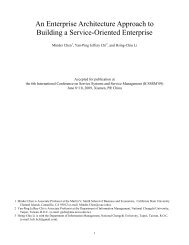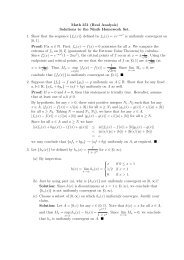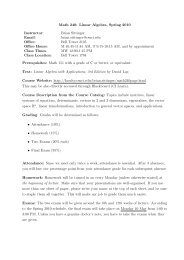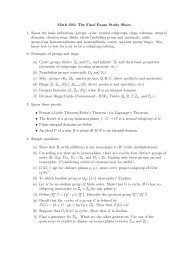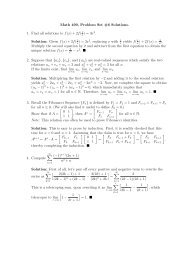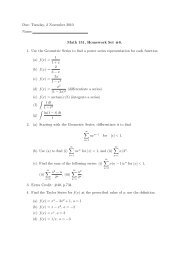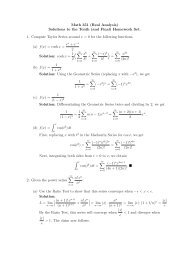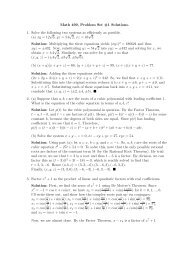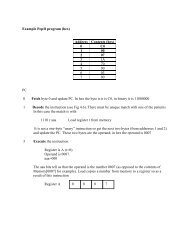GRE Math Subject Test #4 Solutions. 1. B (Calculus/Geometry) This ...
GRE Math Subject Test #4 Solutions. 1. B (Calculus/Geometry) This ...
GRE Math Subject Test #4 Solutions. 1. B (Calculus/Geometry) This ...
You also want an ePaper? Increase the reach of your titles
YUMPU automatically turns print PDFs into web optimized ePapers that Google loves.
43. E (Algebra) Since z is a primitive fifth root of unity, we have z 5 = 1 andz 4 + z 3 + z 2 + z + 1 = 0. Repeated use of these facts reduces the expression to5z 4 = 5e 8πi/5 = −5e 3πi/5 .44. D (Probability) Since this is a binomial trial with p = q = 1 , all we need to do is2compare binomial coefficients C(100, k); the largest ones are those for which thevalues of k are near 50.45. D (Probability) In two words: Pigeonhole Principle.46. E (Abstract Algebra) All three choices yield homomorphisms.47. C (<strong>Calculus</strong>) The unit vector is 1 √2(−1, 0, 1). So, the work equals∫C ⃗ F · d⃗r = ∫ 10√12(−1, 0, 1) · (1, 2t, 3t 2 ) dt = 0.48. A (<strong>Calculus</strong>) The argument is valid.49. D (Abstract Algebra) We want the elements to all have order dividing 4. So, Z 16and Z 8 × Z 2 are not possibilities, while the remaining three Z 2 4, Z 4 × Z 2 2, and Z 4 2 are.50. B (Linear Algebra) |A 2 | = |A| 2 ≥ 0; so II is true. I is false (think of I 2 = I), and IIIis false (consider the diagonal matrix with diagonal entries 1 and −1; it square is I).5<strong>1.</strong> B (<strong>Calculus</strong>) Due to the definition of the floor function, split ths integral at everyinteger∫value:∞0 ⌊x⌋e−x dx = ∑ ∞∫ k+1k=1k·e −x dx = ∑ ∞kk=1 k(e−k −e −k−1 ) = (1−e −1 k)·∑∞k=1= 1 .e k e−1To evaluate this latter sum, differentiate the geometric series and then multiply bothsides by x: = ∑ ∞k=1 kxk . Finally, let x = <strong>1.</strong>ex(1−x) 252. B (Topology/Real Analysis) If A is closed in R, then it must contain its limitpoints, which is any element in R (as both the rational numbers and the irrationalnumbers are dense in R).53. C (<strong>Calculus</strong>) First of all, x + 4z has no critical points; so it suffices to minimizef(x, y, z) = x + 4z subject to g(x, y, z) = x 2 + y 2 + z 2 = 2. By Lagrange Multipliers,∇f = λ∇g√yields (1,√0, 4) = λ(2x, 2y, 2z). Solving this system yields the critical2points (± , 0, ±4 2) yielding the extrema ±√ 34.17 1754. E (<strong>Geometry</strong>) Let r be the radius of the little circle in the second diagram, so themid size circle has radius r(1 + √ 2). Computing the ratio of areas should now bestraightforward.55. D (Discrete <strong>Math</strong>) Recall that n! has ⌊ n 5 ⌋ + ⌊ n 5 2 ⌋ + ... zeros in its decimal expansion.Check that 400! is the first factorial ending in 99 zeros (399! ends in 98 zeros), and404! is the last such factorial. So, there are 5 possibilities.



